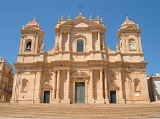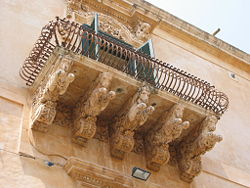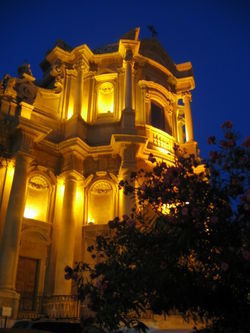
Noto
Encyclopedia



Noto is a city and comune
Comune
In Italy, the comune is the basic administrative division, and may be properly approximated in casual speech by the English word township or municipality.-Importance and function:...
in the Province of Syracuse
Province of Syracuse
The Province of Syracuse is a province in the autonomous island region of Sicily in Italy. Its capital is the city of Syracuse.It has an area of 2,109 km², and a total population of 396,167 ....
, Sicily
Sicily
Sicily is a region of Italy, and is the largest island in the Mediterranean Sea. Along with the surrounding minor islands, it constitutes an autonomous region of Italy, the Regione Autonoma Siciliana Sicily has a rich and unique culture, especially with regard to the arts, music, literature,...
(Italy
Italy
Italy , officially the Italian Republic languages]] under the European Charter for Regional or Minority Languages. In each of these, Italy's official name is as follows:;;;;;;;;), is a unitary parliamentary republic in South-Central Europe. To the north it borders France, Switzerland, Austria and...
). Its located 32 km southwest of the city of Syracuse
Syracuse, Italy
Syracuse is a historic city in Sicily, the capital of the province of Syracuse. The city is notable for its rich Greek history, culture, amphitheatres, architecture, and as the birthplace of the preeminent mathematician and engineer Archimedes. This 2,700-year-old city played a key role in...
at the foot of the Iblean Mountains and gives its name to the surrounding valley, Val di Noto
Val di Noto
Val di Noto is a geographical area of south east Sicily; it is dominated by the limestone Iblean plateau.-The Val di Noto in the Arts:...
. In 2002 Noto and its church were declared a UNESCO
UNESCO
The United Nations Educational, Scientific and Cultural Organization is a specialized agency of the United Nations...
World Heritage Site
World Heritage Site
A UNESCO World Heritage Site is a place that is listed by the UNESCO as of special cultural or physical significance...
.
History
The older town, Noto Antica, lies 8 km directly north on Mount AlveriaMount Alveria
Mount Alveria is a mountain located in the Province of Siracusa, south-eastern Sicily, Italy.-History:This mountainside has been inhabited since prehistoric times. The Elymians lived there before the 10th century B.C. They were followed by the Sicani and then the Siculians. Many Bronze age...
. It was ancient Netum
Netum
Netum or Neetum , was a considerable ancient town in the south of Sicily, near the sources of the little river Asinarus , and about 34 km southwest of Syracuse...
, a city of Sicel origin, left to Hiero II
Hiero II of Syracuse
Hieron II , king of Syracuse from 270 to 215 BC, was the illegitimate son of a Syracusan noble, Hierocles, who claimed descent from Gelon. He was a former general of Pyrrhus of Epirus and an important figure of the First Punic War....
by the Romans
Roman Republic
The Roman Republic was the period of the ancient Roman civilization where the government operated as a republic. It began with the overthrow of the Roman monarchy, traditionally dated around 508 BC, and its replacement by a government headed by two consuls, elected annually by the citizens and...
by the treaty of 263 BCE and mentioned by Cicero
Cicero
Marcus Tullius Cicero , was a Roman philosopher, statesman, lawyer, political theorist, and Roman constitutionalist. He came from a wealthy municipal family of the equestrian order, and is widely considered one of Rome's greatest orators and prose stylists.He introduced the Romans to the chief...
as a foederala citilas (Verr. v. 51, 133), and by Pliny
Pliny the Elder
Gaius Plinius Secundus , better known as Pliny the Elder, was a Roman author, naturalist, and natural philosopher, as well as naval and army commander of the early Roman Empire, and personal friend of the emperor Vespasian...
as Latinae conditionis (Hist. Nat. iii. 8. 14). According to legend, Dedalus stopped here after his flight over the Ionian Sea
Ionian Sea
The Ionian Sea , is an arm of the Mediterranean Sea, south of the Adriatic Sea. It is bounded by southern Italy including Calabria, Sicily and the Salento peninsula to the west, southern Albania to the north, and a large number of Greek islands, including Corfu, Zante, Kephalonia, Ithaka, and...
, as well as Hercules
Hercules
Hercules is the Roman name for Greek demigod Heracles, son of Zeus , and the mortal Alcmene...
, after his seventh task.

Verres
Gaius Verres was a Roman magistrate, notorious for his misgovernment of Sicily. It is not known what gens he belonged to, though some give him the nomen Licinius.-As governor:...
. In 866 it was conquered by the Arab
Arab
Arab people, also known as Arabs , are a panethnicity primarily living in the Arab world, which is located in Western Asia and North Africa. They are identified as such on one or more of genealogical, linguistic, or cultural grounds, with tribal affiliations, and intra-tribal relationships playing...
s, who elevated to a capital city of one of three districts of the island (the Val di Noto). Later it was a rich Norman city.
In the 16th and 17th centuries, the city brought forth several notable intellectual figures, including Giovanni Aurispa
Giovanni Aurispa
Giovanni Aurispa was an Italian historian and savant of the 15th century. He is remembered in particular as a promoter of the revival of the study of Greek in Italy. It is to Aurispa that the world is indebted for preserving the greater part of our knowledge of the Greek classics.-Life:He was...
, jurists Andrea Barbazio and Antonio Corsetto, as well as the architect Matteo Carnelivari and the minor composer Mario Capuana
Mario Capuana
Mario Capuana was an Italian composer of motets and a requiem.He was maestro di capella at the Cathedral of Noto in the Province of Syracuse from 1628 to his death in 1647...
. In 1503 king Ferdinand III
Ferdinand II of Aragon
Ferdinand the Catholic was King of Aragon , Sicily , Naples , Valencia, Sardinia, and Navarre, Count of Barcelona, jure uxoris King of Castile and then regent of that country also from 1508 to his death, in the name of...
gave it the title of civitas ingeniosa ("ingenious city"). In the following centuries, the city expanded enlarging its medieval limits; and new buildings, churches and convents were built. These, however, were all totally destroyed by the 1693 earthquake
1693 Sicily earthquake
The 1693 Sicily earthquake refers to a powerful earthquake that struck parts of southern Italy, notably Sicily, Calabria and Malta on January 11, 1693 around 9 pm local time. This earthquake was preceded by a damaging foreshock on January 9th...
. The devastation of the city on Mount Alveria was accompanied by its economy, which relied mainly on agricultural products– vine, oil, cereals, rice, cotton– and its renowned handicrafts.
The current town, rebuilt after the earthquake on the left bank of River Asinaro
Asinaro
Asinaro is a river in Sicily in the province of Syracuse. It is 22km long, flowing from the Hyblaean Mountains into the Ionian Sea. It passes through the UNESCO World Heritage city of Noto....
, was planned on a grid system by Giovanni Battista Landolina
Giovanni Battista Landolina
Giovanni Battista Landolina, "Marchese di S. Alfano", was a Sicilian landowner and intellectual instrumental in having the city of Noto removed from its former site on Mount Alveria to a more level location following the earthquake in 1693 centred on the Val di Noto...
. This new city occupied a position nearer to the Ionian Sea. The presence of architects like Rosario Gagliardi
Rosario Gagliardi
Rosario Gagliardi was a Sicilian architect born in Syracuse. He was one of the leading architects working in the Sicilian Baroque. In spite of never leaving Sicily his work showed great understanding of the style, but was a progression from the style of baroque as deployed by Bernini...
, Francesco Sortino and others, made the new Noto a masterpiece of Sicilian Baroque
Sicilian Baroque
Sicilian Baroque is the distinctive form of Baroque architecture that took hold on the island of Sicily, off the southern coast of Italy, in the 17th and 18th centuries...
, dubbed the "Stone Garden" by Cesare Brandi
Cesare Brandi
Cesare Brandi was an art critic and historian, specialist in conservation-restoration theory....
and is currently listed among UNESCO
UNESCO
The United Nations Educational, Scientific and Cultural Organization is a specialized agency of the United Nations...
's World Heritage Sites. The new structures are characterized by a soft tufa stone, which under sunlight assumes a typical honey tonality. Parts of the cathedral suddenly collapsed in 1996, a great loss to Sicilian Baroque.
The city, which had lost its provincial capital status in 1817, rebelled against the House of Bourbon
House of Bourbon
The House of Bourbon is a European royal house, a branch of the Capetian dynasty . Bourbon kings first ruled Navarre and France in the 16th century. By the 18th century, members of the Bourbon dynasty also held thrones in Spain, Naples, Sicily, and Parma...
on May 16, 1860, leaving its gates open to Giuseppe Garibaldi
Giuseppe Garibaldi
Giuseppe Garibaldi was an Italian military and political figure. In his twenties, he joined the Carbonari Italian patriot revolutionaries, and fled Italy after a failed insurrection. Garibaldi took part in the War of the Farrapos and the Uruguayan Civil War leading the Italian Legion, and...
and his expedition. Five months later, on October 21, a plebiscite sealed the annexation of Noto to Piedmont
Piedmont
Piedmont is one of the 20 regions of Italy. It has an area of 25,402 square kilometres and a population of about 4.4 million. The capital of Piedmont is Turin. The main local language is Piedmontese. Occitan is also spoken by a minority in the Occitan Valleys situated in the Provinces of...
.
In 1844, Noto was named a bishopric seat, but in 1866 suffered the abolition of the religious guilds, which were deeply linked to the city's structures and buildings.
Noto was freed from fascist dictatorship in July 1943. At the referendum of 1946, the Notinesi people voted in favour of the monarchy.
Main sights
Noto is famous for its fine buildings of the early 18th century, considered among the main masterpieces in the Sicilian baroqueSicilian Baroque
Sicilian Baroque is the distinctive form of Baroque architecture that took hold on the island of Sicily, off the southern coast of Italy, in the 17th and 18th centuries...
style. It is a place of many religious buildings, there are several palaces, and many others. The old has mixed with the new, and a view from the top of a building on the hill will show the older buildings mixed with new and rebuilt architecture.
Palaces and other buildings
- Ducezio Palace, the current Town Hall. Designed by Vincenzo SinatraVincenzo SinatraVincenzo Sinatra was a Sicilian architect. He was a pupil of Rosario Gagliardi. Sinatra worked in both the Baroque style and later in Neo-Classical style....
, it houses neo-classical style frescoes by Antonio Mazza. - Astuto Palace.
- Villadorata palace on Via Nicolaci which was built by P. Labisi in 1733.
Religious buildings
- Cathedral of San Nicolò di Mira (finished 1776).
- Church of Santa Caterina.
- Church of San Corrado.
- Church of the Collegio di San Carlo.
- Church of the Sacro Nome di Gesu.
- Monastery of Santa Chiara (1735), designed by Gagliardi. It has an oval plant, the interior divided by twelve columns housing a Madonna with Child from the 16th century.
- Church of San Michele Arcangelo.
- Church of Santa Maria della Scala.
- Church of Santissimo Salvatore.
- Town Library.
- Church of San Nicola di Mira.
- Church of Santa Chiara, with a precious Madonna by Antonello GaginiAntonello GaginiAntonello Gagini was an Italian sculptor of the Renaissance, mainly active in Sicily and Calabria.Antonello was a member of a family of sculptors and artisans, originally from Northern Italy, but active throughout Italy, including Genoa, Florence, and Rome. The family includes his father, Domenico...
. - Church of San Francesco d'Assisi (Immacolata).
- Church of the Spirito Santo.
- Church of Ecce Homo.
- Church of Santa Maria dell'Arco.
- Church of the Anime Sante del Purgatorio ("Holy Souls of the Purgatory").
- Church of Santa Maria della Rotonda.
- Church of the Santissima Trinità.
- Church of San Carlo al Corso (by Rosario GagliardiRosario GagliardiRosario Gagliardi was a Sicilian architect born in Syracuse. He was one of the leading architects working in the Sicilian Baroque. In spite of never leaving Sicily his work showed great understanding of the style, but was a progression from the style of baroque as deployed by Bernini...
). - Church of Santa Maria del Carmelo.
- Church of San Pietro Martire.
- Church of San Michele Arcangelo.
- Church of San Domenico (by Rosario GagliardiRosario GagliardiRosario Gagliardi was a Sicilian architect born in Syracuse. He was one of the leading architects working in the Sicilian Baroque. In spite of never leaving Sicily his work showed great understanding of the style, but was a progression from the style of baroque as deployed by Bernini...
). - Church of Sant'Antonio Abate.
- Church of Santa Caterina.
- Church of the Crociferio di San Camillo.
- Church of Montevergine (San Girolamo).
- Church of Santissimo Salvatore.
- Church of San Andrea Apostolo.
- Church of San Pietro delle Rose (Saints Peter and Paul).
- Church of the SS. Crocifisso.
- Church of Sant'Egidio Vescovo.
- Church of Santa Maria del Gesù.
- Church of Annunziata.
- Church of Santa Agata.
Archaeological finds
The remains of Noto's early inhabitants are almost entirely hidden beneath the ruins of the mediaeval town, except for three chambers cut into the rock. One is noted by an inscription in the library at Noto to have belonged to the gymnasium, while the other two were heroa (shrines of heroes). But explorations have brought to light four cemeteries of the third Sicel period, and one of the GreekArchitecture of Ancient Greece
The architecture of Ancient Greece is the architecture produced by the Greek-speaking people whose culture flourished on the Greek mainland and Peloponnesus, the Aegean Islands, and in colonies in Asia Minor and Italy for a period from about 900 BC until the 1st century AD, with the earliest...
period, of the 3rd and 2nd centuries BC. There are also catacombs of the Christian period and some Byzantine tombs.
Four miles to the south of Noto, on the left bank of the Tellaro (Helorus) stands a stone column about 10 metres high, which is believed to be a memorial of the surrender of Nicias
Nicias
Nicias or Nikias was an Athenian politician and general during the period of the Peloponnesian War. Nicias was a member of the Athenian aristocracy because he had inherited a large fortune from his father, which was invested into the silver mines around Attica's Mt. Laurium...
. In the 3rd century BC, a tomb was excavated in the rectangular area which surrounds it, destroying apparently a pre-existing tomb. The later burial belongs to the necropolis of the small town of Heloron, 750 m to the southeast, some remains of which have been discovered. It was a small advanced post of Syracuse, belonging probably to the 6th century BC.
Culture
In the Noto neighbourhood, a 32-m radiotelescope was installed by the Istituto di Radioastronomia di BolognaIstituto di Radioastronomia di Bologna
The Istituto di Radioastronomia di Bologna is one of the Italian institutes that had already been part of the Consiglio Nazionale delle Ricerche , now part of the Istituto Nazionale di Astrofisica .Many learned researchers in astronomy, physics, engineering or...
as part of the Consiglio Nazionale delle Ricerche
Consiglio Nazionale delle Ricerche
The Consiglio Nazionale delle Ricerche or National Research Council, is an Italian public organization set up to support scientific and technological research. Its headquarters are in Rome.-History:The institution was founded in 1923...
. It works in collaboration with a similar instrument in Medicina
Medicina
Medicina is an Italian comune with c. 16,000 inhabitants in the province of Bologna, part of the region of Emilia-Romagna.-Name:The origins of its name are quite uncertain and many hypotheses have been made on it...
, Bologna
Province of Bologna
The Province of Bologna is a province in the Emilia-Romagna region of Italy. Its capital is the city of Bologna.-Geography:It has an area of 3,702 km², and a total population of 991,647 . There are 60 comuni in the province, see Comuni of the Province of Bologna...
.
The city has held an annual flower festival, the Infiorata, every May since the 1980s, lining the streets with floral works of art.

